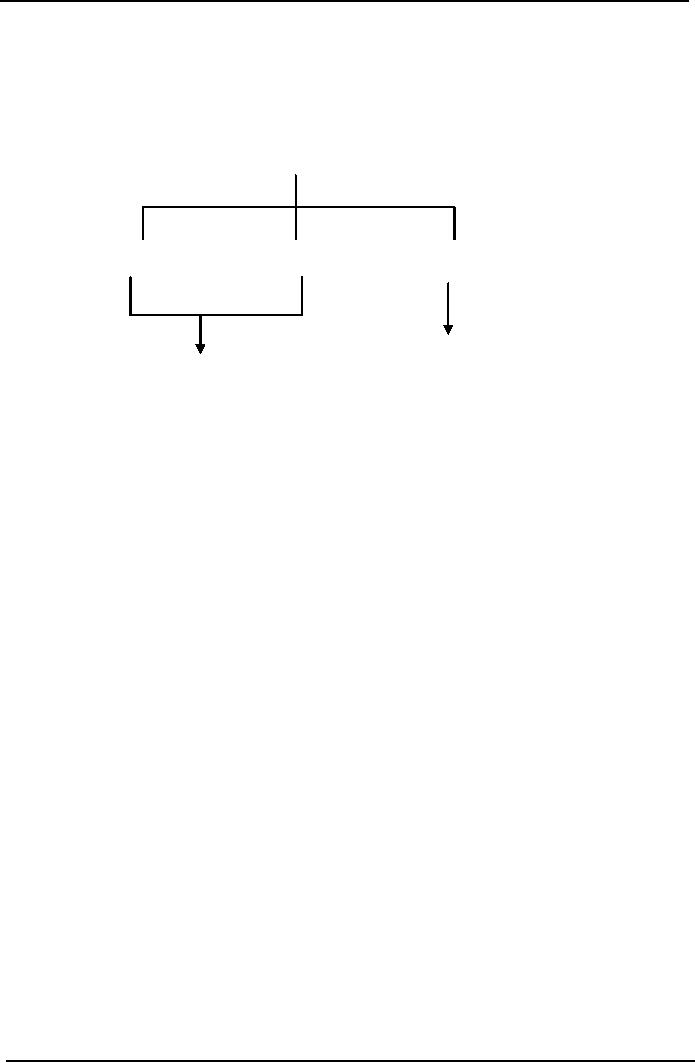 |

Cost
& Management Accounting
(MGT-402)
VU
LESSON#
27 & 28
MARGINAL
AND ABSORPTION COSTING
(Product
costing systems)
Following
diagram helps to recall the
behavior of different cost
elements.
Cost
Elements
Direct
Material
Direct
Labor
Factory
Overhead Cost
Variable
& Fixed Cost
Variable
Cost
Marginal
cost is the cost the
variable cost that changes
with the production of each
next unit.
Marginal
and Absorption Costing
So
far we
have
been looking at the various
different types of cost and
have gradually built up
the
total
cost of a cost unit by
aggregating the cost of direct
materials, direct labor, direct
expenses,
variable
overheads and fixed
overheads (absorbed into
cost units). We can display
this total cost as
part
of a profit and loss account
(namely cost of sales). In
doing so we must remember to
adjust
the
profit and loss account
for any overhead under- or
over-absorbed.
This
adjustment is only necessary
because we are including
fixed overheads in the cost
of the cost
unit.
In other words, we are presenting
cost information according to
absorption costing
principles.
However, there is another
method of presenting cost information,
i.e. marginal costing.
Marginal
Costing
Under
this system, we do not
attempt to absorb fixed
overheads into cost units,
and so we avoid
the
difficulties of setting absorption rate,
adjusting for under or over-absorbed
overhead, etc.
Cost
units are valued at their marginal
cost only (not their
fully absorbed cost). In other
words the
cost
of a cost unit is presented as
the total of direct materials, direct
labor, direct expenses
and
variable
overheads (but not fixed
overheads).
Of
course, this does not
mean that we can simply
ignore fixed overheads It is simply
that we
choose
to treat all fixed overheads as period
costs, rather than trying to
attribute them to
individual
cost
units You will find that
this presentation of cost information
has distinct advantages
over-
absorption
costing when it comes to decision
making.
A
key concept in marginal costing is that of
contribution margin.
Contribution
Margin is defined as
the sales value of a cost
unit minus its variable
cost.
Absorption
and marginal
costing
167

Cost
& Management Accounting
(MGT-402)
VU
In
absorption
costing, fixed
manufacturing overheads are
absorbed into cost units.
Thus stock is
valued
at absorption cost and fixed
manufacturing overheads are
charged in the profit and
loss
account
of the period in which the
units are sold.
In
marginal
costing,
fixed manufacturing overheads
are not absorbed into
cost units, Stock is
valued
at marginal (or variable) cost and
fixed manufacturing overheads
are treated as period
costs
and
are charged in the profit
and loss account of the
period in which the overheads
are incurred.
Practice
Question
A
Company produces a single
product and has the
following budget:
Company
Budget Cost Per
Unit
Rs.
Selling
price
10
Direct
materials
3
Direct
wages
2
Variable
overhead
1
Fixed
production overhead is Rs.
10,000 per month; production
volume is 5,000 units per
month.
Calculate
the cost per unit to be
used for stock valuation
under:
(a)
Absorption costing
(b)
Marginal costing.
Solution
(a)
Absorption cost per
unit
Rs
Direct
materials
3
Direct
wages
2
Variable
overhead
1
Absorbed
fixed overhead
Rs
10,000
2
5000
units
Cost
per Unit
8
(b)
Marginal
cost per unit
Direct
materials
3
Direct
wages
2
Variable
overhead
1
Cost
per Unit
6
The
stock valuation will be different
for marginal and absorption costing.
Under absorption
costing
stock will include variable
and fixed overheads whereas
under marginal costing stock will
only
include variable
overheads.
Further
practice question explaining the concept
of product cost, period cost
and cost per
unit
under
two product costing
systems:
168
Table of Contents:
- COST CLASSIFICATION AND COST BEHAVIOR INTRODUCTION:COST CLASSIFICATION,
- IMPORTANT TERMINOLOGIES:Cost Center, Profit Centre, Differential Cost or Incremental cost
- FINANCIAL STATEMENTS:Inventory, Direct Material Consumed, Total Factory Cost
- FINANCIAL STATEMENTS:Adjustment in the Entire Production, Adjustment in the Income Statement
- PROBLEMS IN PREPARATION OF FINANCIAL STATEMENTS:Gross Profit Margin Rate, Net Profit Ratio
- MORE ABOUT PREPARATION OF FINANCIAL STATEMENTS:Conversion Cost
- MATERIAL:Inventory, Perpetual Inventory System, Weighted Average Method (W.Avg)
- CONTROL OVER MATERIAL:Order Level, Maximum Stock Level, Danger Level
- ECONOMIC ORDERING QUANTITY:EOQ Graph, PROBLEMS
- ACCOUNTING FOR LOSSES:Spoiled output, Accounting treatment, Inventory Turnover Ratio
- LABOR:Direct Labor Cost, Mechanical Methods, MAKING PAYMENTS TO EMPLOYEES
- PAYROLL AND INCENTIVES:Systems of Wages, Premium Plans
- PIECE RATE BASE PREMIUM PLANS:Suitability of Piece Rate System, GROUP BONUS SYSTEMS
- LABOR TURNOVER AND LABOR EFFICIENCY RATIOS & FACTORY OVERHEAD COST
- ALLOCATION AND APPORTIONMENT OF FOH COST
- FACTORY OVERHEAD COST:Marketing, Research and development
- FACTORY OVERHEAD COST:Spending Variance, Capacity/Volume Variance
- JOB ORDER COSTING SYSTEM:Direct Materials, Direct Labor, Factory Overhead
- PROCESS COSTING SYSTEM:Data Collection, Cost of Completed Output
- PROCESS COSTING SYSTEM:Cost of Production Report, Quantity Schedule
- PROCESS COSTING SYSTEM:Normal Loss at the End of Process
- PROCESS COSTING SYSTEM:PRACTICE QUESTION
- PROCESS COSTING SYSTEM:Partially-processed units, Equivalent units
- PROCESS COSTING SYSTEM:Weighted average method, Cost of Production Report
- COSTING/VALUATION OF JOINT AND BY PRODUCTS:Accounting for joint products
- COSTING/VALUATION OF JOINT AND BY PRODUCTS:Problems of common costs
- MARGINAL AND ABSORPTION COSTING:Contribution Margin, Marginal cost per unit
- MARGINAL AND ABSORPTION COSTING:Contribution and profit
- COST – VOLUME – PROFIT ANALYSIS:Contribution Margin Approach & CVP Analysis
- COST – VOLUME – PROFIT ANALYSIS:Target Contribution Margin
- BREAK EVEN ANALYSIS – MARGIN OF SAFETY:Margin of Safety (MOS), Using Budget profit
- BREAKEVEN ANALYSIS – CHARTS AND GRAPHS:Usefulness of charts
- WHAT IS A BUDGET?:Budgetary control, Making a Forecast, Preparing budgets
- Production & Sales Budget:Rolling budget, Sales budget
- Production & Sales Budget:Illustration 1, Production budget
- FLEXIBLE BUDGET:Capacity and volume, Theoretical Capacity
- FLEXIBLE BUDGET:ANALYSIS OF COST BEHAVIOR, Fixed Expenses
- TYPES OF BUDGET:Format of Cash Budget,
- Complex Cash Budget & Flexible Budget:Comparing actual with original budget
- FLEXIBLE & ZERO BASE BUDGETING:Efficiency Ratio, Performance budgeting
- DECISION MAKING IN MANAGEMENT ACCOUNTING:Spare capacity costs, Sunk cost
- DECISION MAKING:Size of fund, Income statement
- DECISION MAKING:Avoidable Costs, Non-Relevant Variable Costs, Absorbed Overhead
- DECISION MAKING CHOICE OF PRODUCT (PRODUCT MIX) DECISIONS
- DECISION MAKING CHOICE OF PRODUCT (PRODUCT MIX) DECISIONS:MAKE OR BUY DECISIONS